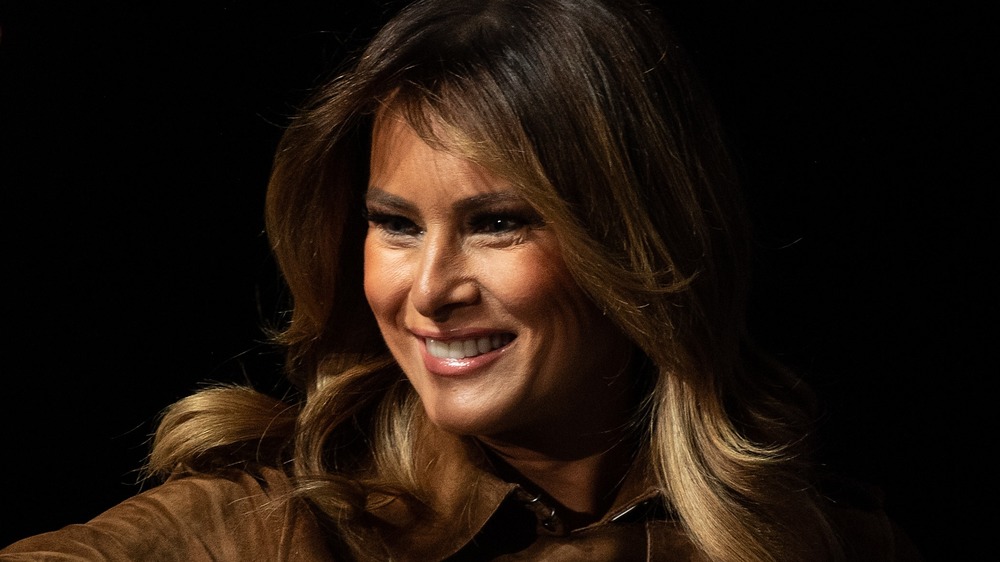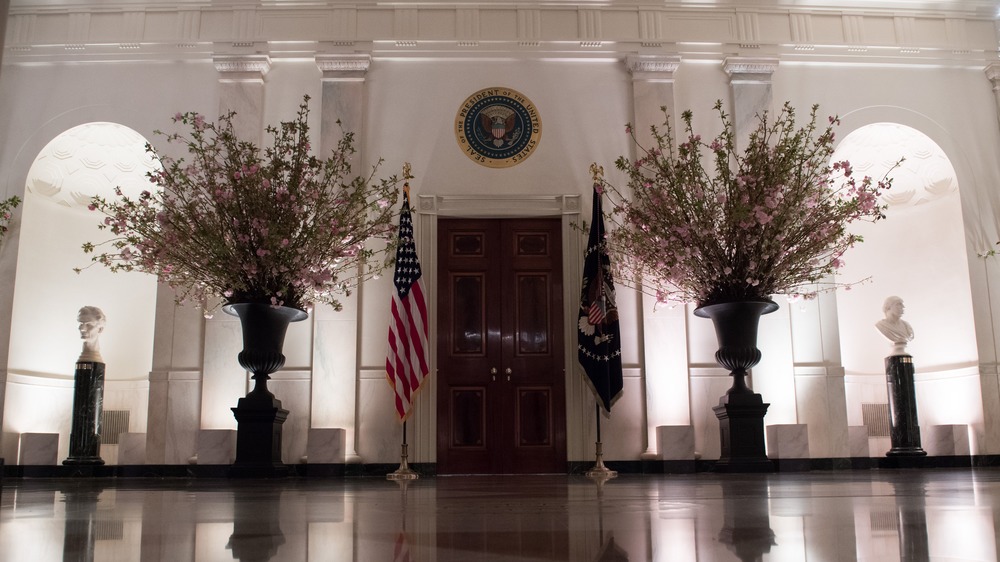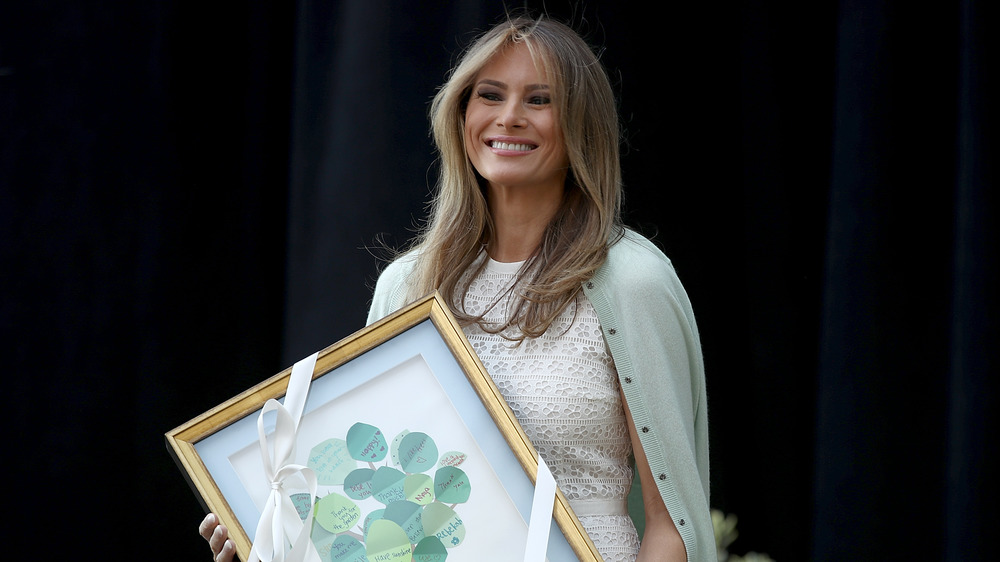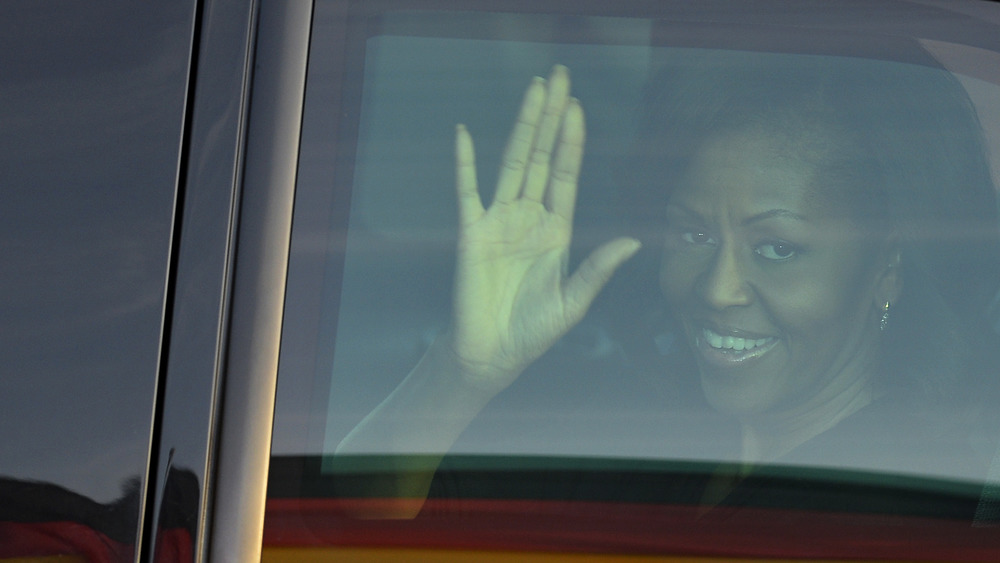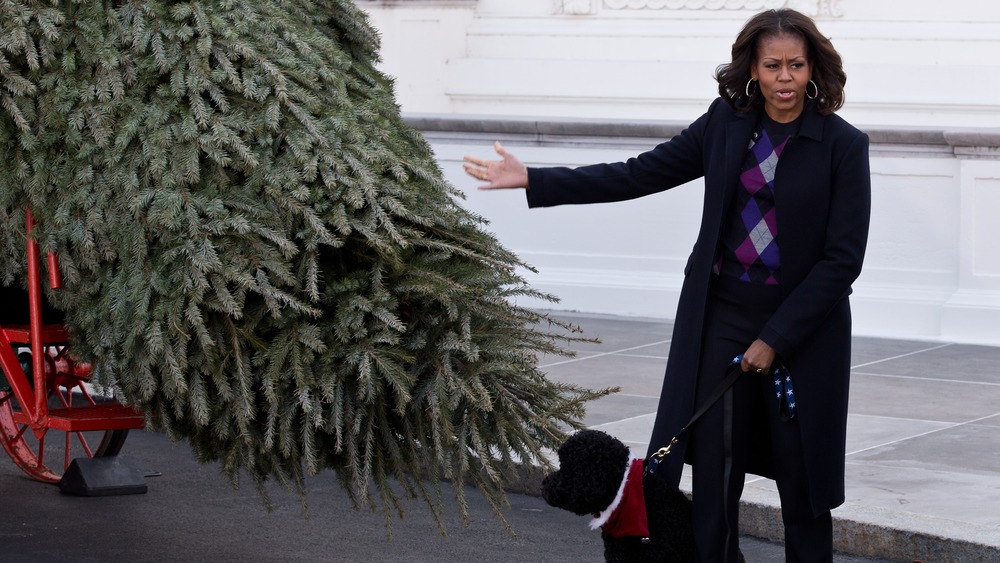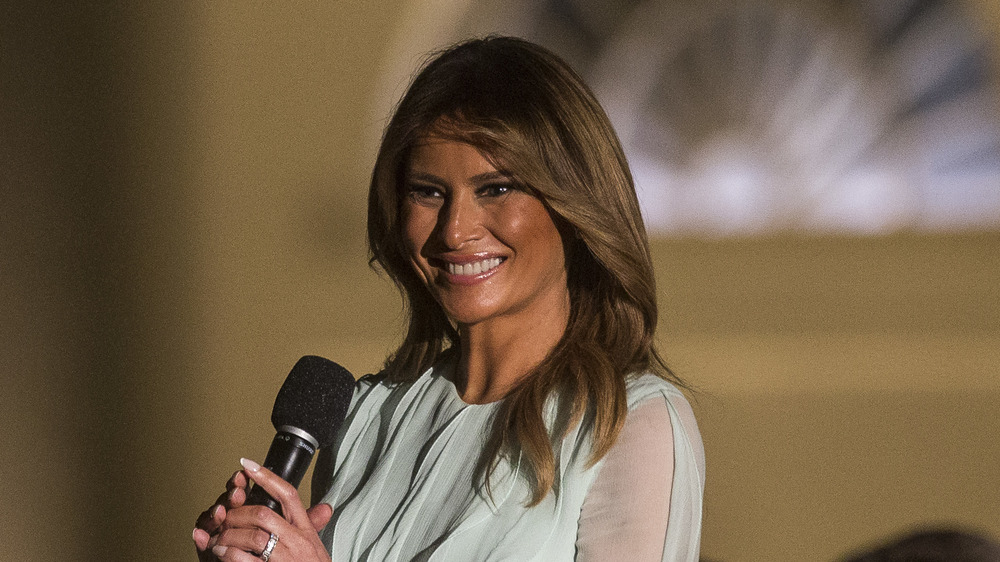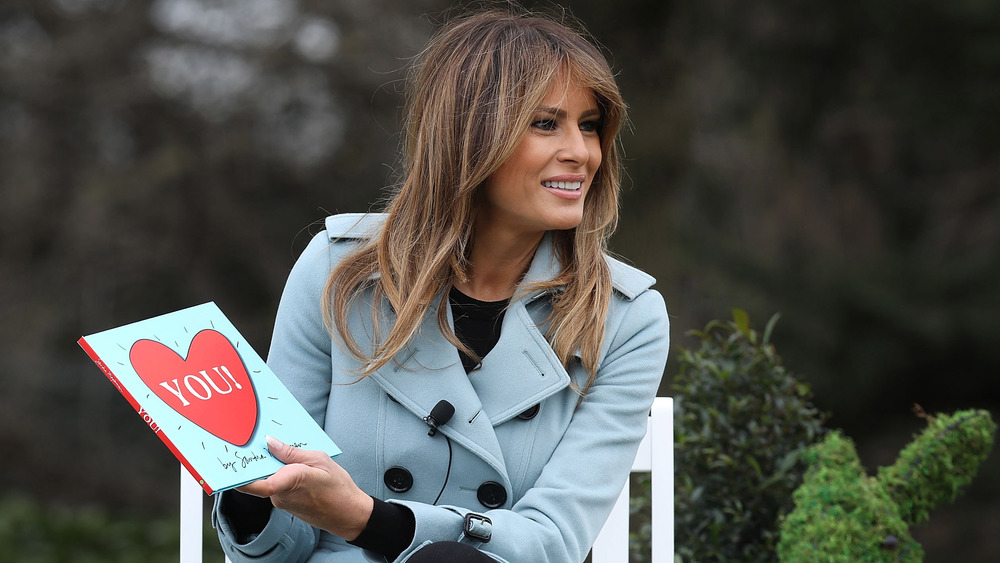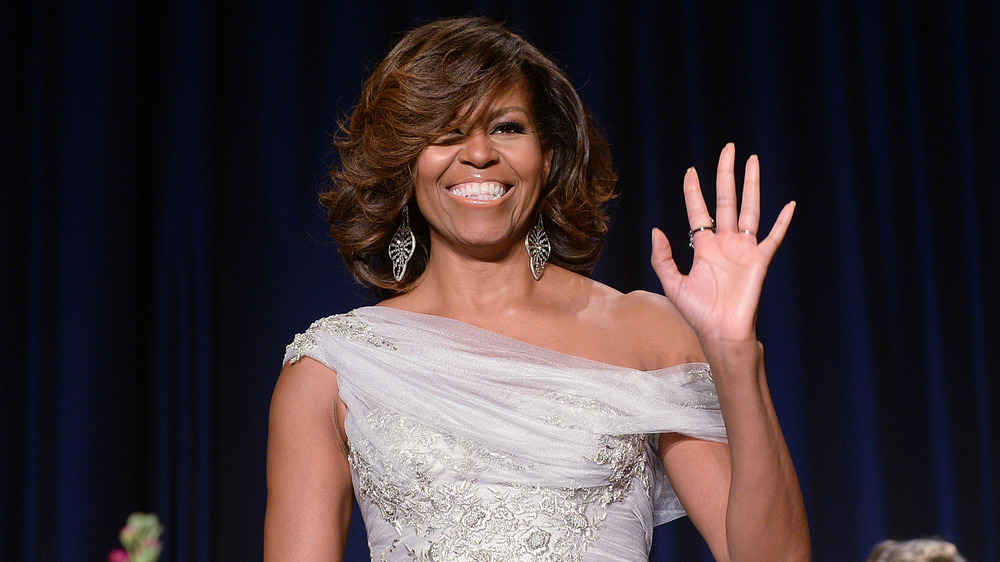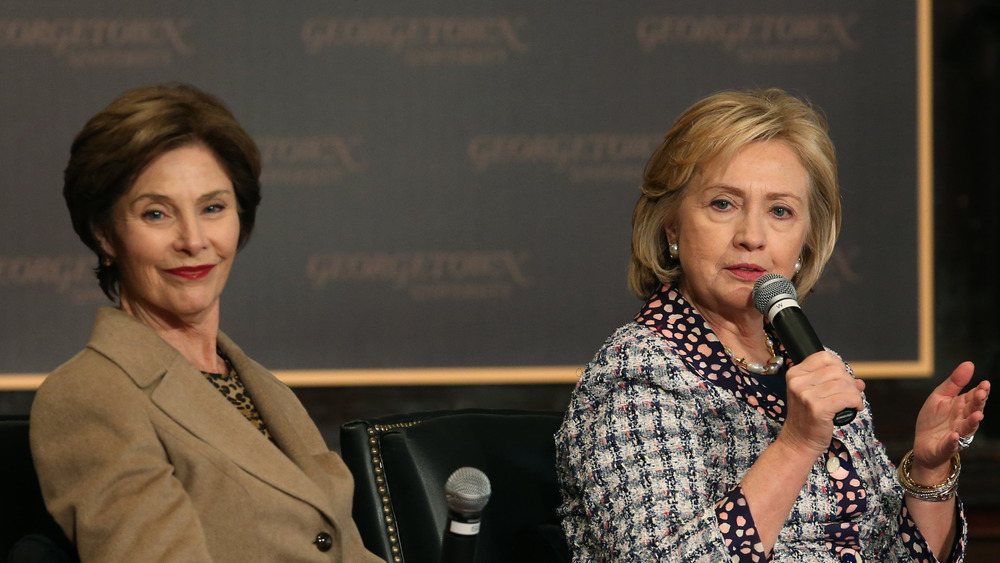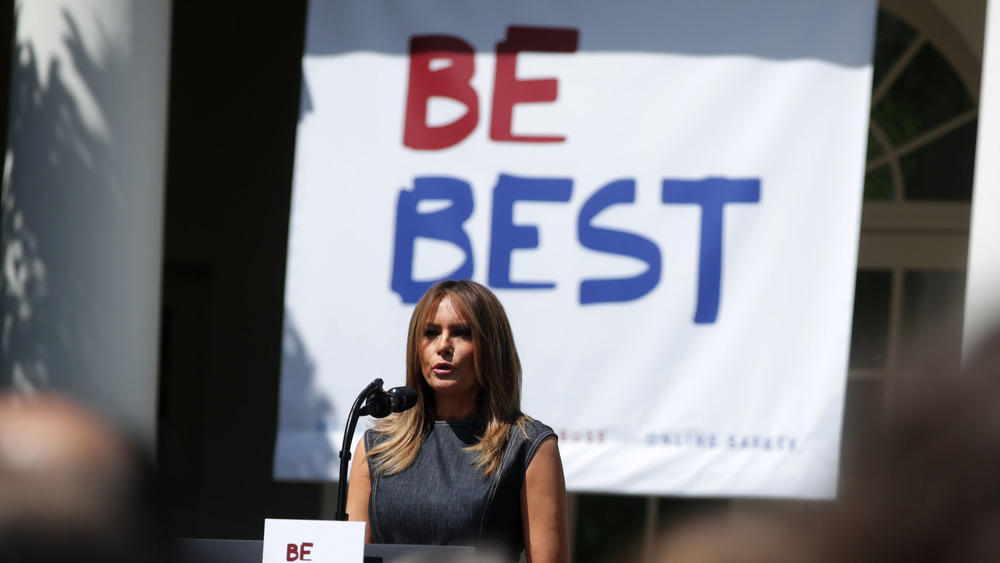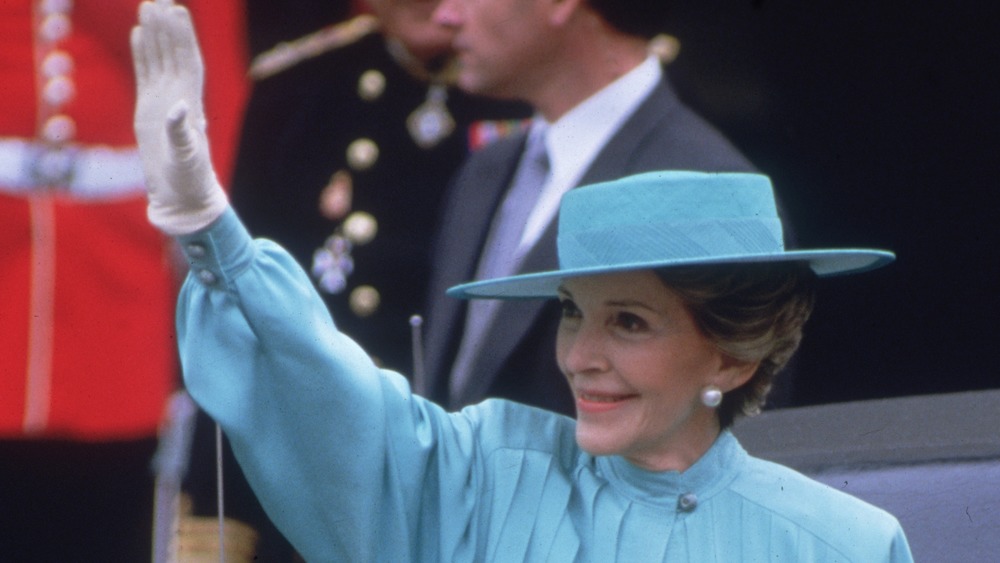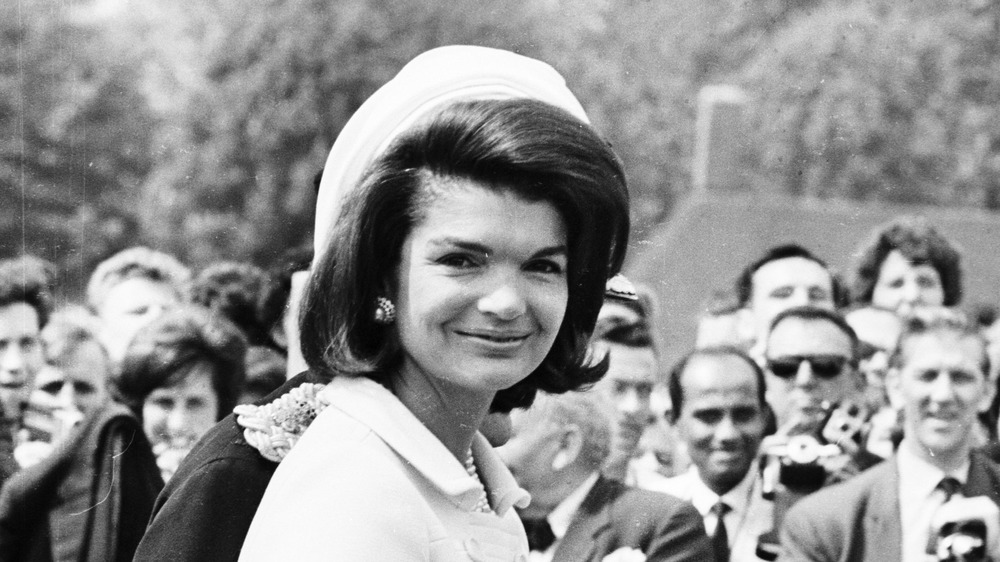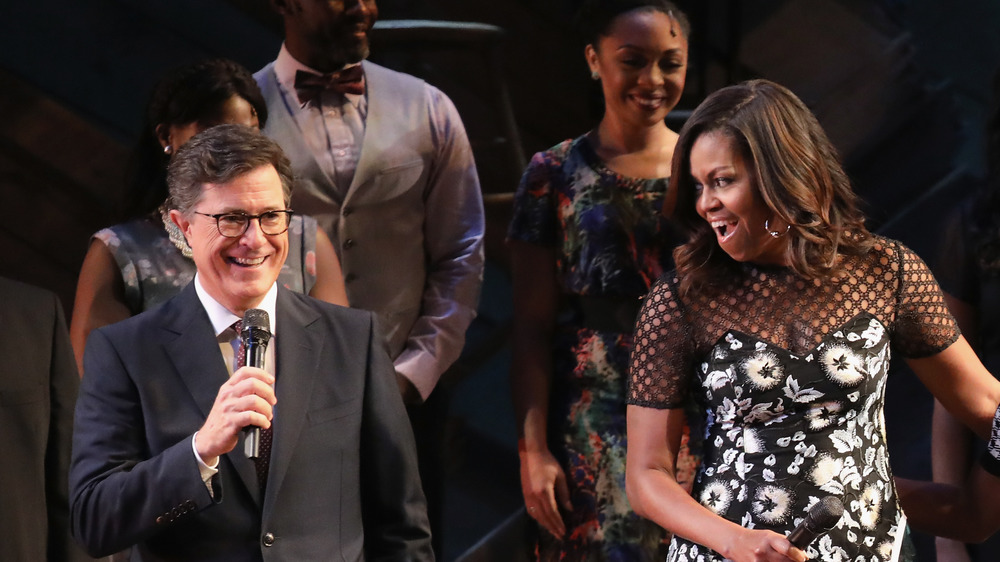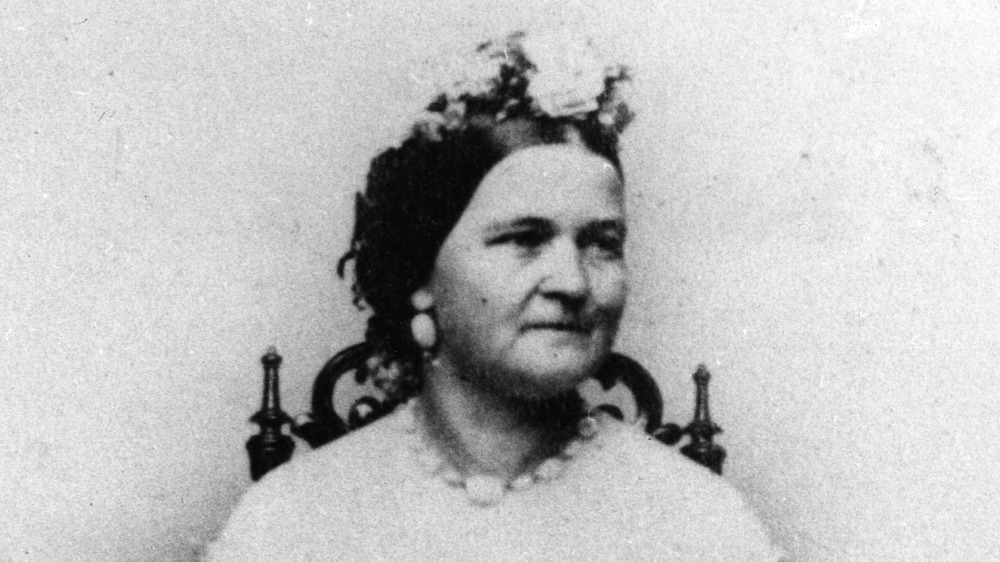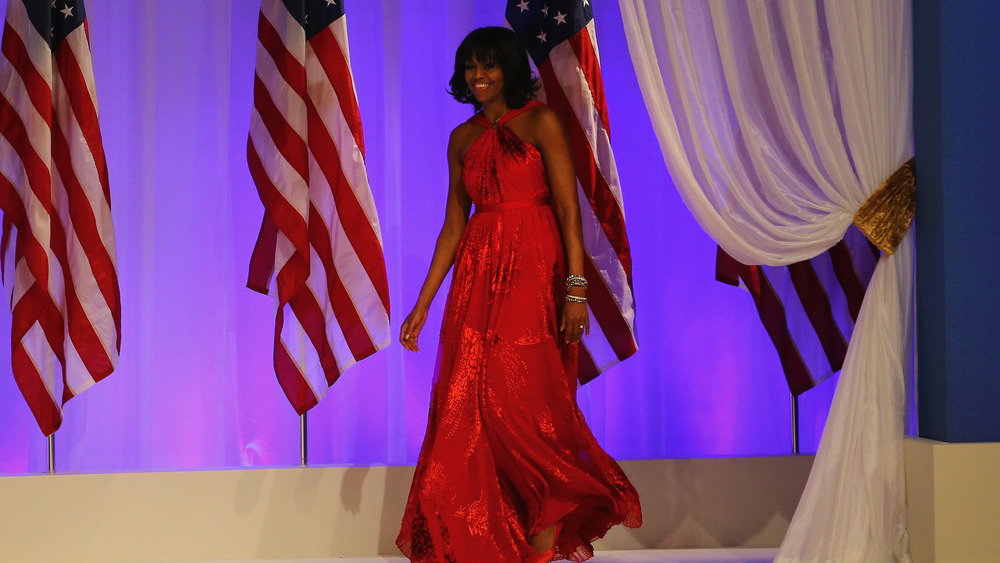Weird Rules The First Lady Is Forced To Follow
The first lady has many roles: fashion icon, hostess, humanitarian. She has lots of jobs to do, all while being watched by the public. She's also attached to the most powerful man in the country, but she doesn't have an official political role herself. America's first ladies are controversially not paid for their work in the White House, even though they are busy with tasks.
The first lady isn't free to do as she pleases. No, there are certain rules she has to follow in order to keep with tradition and stay in public favor. Some of these expectations are straightforward while other rules are more surprising and just downright weird.
As glamorous as the position may seem to you now, you may think otherwise after reading all of the rules the first lady is forced to follow. Keep on reading to see.
The first lady must only decorate certain parts of the White House
First ladies have the daunting job of decorating the White House once they move in. However, they can only add personal touches to the spaces in which they live: mainly the second and third floors of the house. Historic rooms, like the Lincoln Room, are untouchable. Kate Andersen Brower, who wrote First Women: The Grace and Power of America's Modern First Ladies, explained it to ABC News this way: "Some parts are essentially historic rooms and belong to the American people, not to the families who live there."
First ladies also have to keep up with what needs to be refurbished in the public spaces of the White House. According to Slate, if the president or first lady wants to make changes to the public rooms, approval is needed from the Committee for the Preservation of the White House.
An amazing perk of decorating the White House is access to the confidential warehouse full of past White House furniture, as reported by Departures. The first lady can choose from this storehouse, and she can also hire an interior designer to help her pick out new furniture and decor. Anyone else dying to see Chip and Joanna Gaines decorate the White House?
The first lady can't accept gifts
You'd think that gifts given to the president and first lady would be theirs to keep. The truth is that presents from foreign governments belong to the United States, according to the Congressional Research Service. The National Archives and Records Administration keeps the gift, and it later goes to a Presidential Library. If the president or first lady wants to keep the gift, they can purchase it, according to AOL.
As the publication detailed, Nancy and Ronald Reagan were gifted two live eagles from the German chancellor in the 1980s. The Reagans also received a horse from Mexican President José López Portillo. Those gifts must have been a little trickier to store.
There is an exception to this rule, though. The first lady is allowed to accept domestic gifts, according to the Ronald Reagan Presidential Library. The first lady can do what she pleases with these gifts, and she doesn't have to pay for them in order to keep them. Nevertheless, these presents go through significant security screenings before reaching the president's wife. Nothing is simple when you're the first lady.
The first lady isn't allowed to open windows
"In the White House, you can't open a window," Michelle Obama admitted to Oprah Winfrey in an interview. She continued, "Sasha opened her window once — there were calls. 'Shut the window!' It never opened again." Sounds intense!
Security is always taken very seriously, and that extends to something as seemingly small as opening a window — even in a car. Michelle Obama told Stephen Colbert on The Late Show about this strict rule, saying, "One day as a treat, my lead agent let me have the windows open on the way to Camp David."
After visiting Melania Trump, French First Lady Brigitte Macron told Le Monde (via The Guardian), "She can't even open a window at the White House. She can't go outside. She's much more constrained than I am. I go out every day in Paris." As if we needed a reminder that life is better in Paris.
The first lady must pick a theme for the annual Christmas tree
Basically everyone who celebrates Christmas aspires to have a Pinterest-worthy Christmas tree, but the first lady has a whole other level of pressure on her to make her trees beautiful. First Lady Jackie Kennedy started the tradition of themed Christmas trees in the Blue Room at the White House. In 1961, she decorated a tree with a Nutcracker theme, according to the White House Historical Association.
Barbara Bush also went with a Nutcracker theme in 1990. Following in her footsteps, Hillary Clinton chose to decorate her tree based on "'Twas the Night Before Christmas" in 1995. In 2010, Michelle Obama opted for a "Gift of the American Spirit" theme. Melania Trump chose the theme "The Spirit of America" for Christmas 2019, reported Fox News. This theme included two pink and gold trees as a tribute to past first ladies.
The Christmas tree in the Blue Room isn't the only Christmas decoration in the White House. Mamie Eisenhower was extra — she had 26 trees up while she was there. Her record was beat by Hillary Clinton, who had 37 trees put up. Melania Trump went further still and put up 41 trees along with smaller topiary trees.
The first lady has to host the state dinner
Gifts are usually given to the first lady when a foreign government visits the White House. In honor of these foreign friends, a state dinner is also held. The first lady is the hostess of this dinner. According to the White House Historical Association, "The First Lady and her staff are responsible for the elaborate planning and attention behind the glitter and ceremony of the state dinner. These formal dinners involve the creation of invitations and guest lists, menus, flowers, table settings, seating arrangements and entertainment for the evening."
Luckily for the first lady, she has chefs on hand to make the food. According to the White House Museum, First Lady Mamie Eisenhower liked to choose the menu for dinners. Some first ladies, like Pat Nixon, were more hands-off.
In 2012, Michelle Obama also started a Kids' State Dinner. Children from every state were invited to showcase healthy recipes they created and the winning dishes were served. At the second annual Kids' State Dinner, then-First Lady Michelle Obama told attendees, "This is what it's like to be a part of an official state dinner. We mirrored it exactly to what people experience when we host world leaders here."
The first lady has to host the annual Easter Egg Roll
A first lady's job is never done. As the National Museum of American History says, first ladies are "hostesses for the nation and the presidential administrations." Ever the hostess, she is expected to plan a fun event for kids at the White House every year: the Easter Egg Roll.
The White House website once described the first lady's role at the event, saying, "The planning of the egg roll traditionally falls on first ladies, each incorporating her own tastes and interests to the event." The site goes on to give examples: "First Lady Lou Hoover had part of the South Lawn roped off for folk dancing. First Lady Pat Nixon introduced the traditional egg roll races."
In 1981, Nancy Reagan started the tradition of giving children wooden Easter eggs. These eggs had signatures from famous people scrawled across them. Reagan's plans for her Easter Egg Rolls also included balloons from the Macy's Thanksgiving Day Parade and Broadway show performances. Wow!
The first lady is expected to attend the White House correspondents' dinner
Every year, celebrities and journalists attend the White House correspondents' dinner. It's usually hosted by a comedian, and the president makes some jokes of his own as well, as Barack Obama demonstrated in 2016. The dinner is held by the White House Correspondents' Association, which describes the purpose behind the event as a way to
"salute the First Amendment" and "honor award-winning journalism." The association's website goes on to explain that dinner is "traditionally" attended by both the president and his wife, the first lady.
The first dinner was held in 1921, though the first president to attend one (Calvin Coolidge) came in 1924. According to ABC News, it was in the 1980s that the dinner started to include big name celebrities and after-parties began happening as well.
Despite attendance being considered pretty much mandatory, First Lady Melania Trump and President Donald Trump have broken this unspoken rule. As The Washington Post reported in 2019, Donald Trump was "the first among the last 15 presidents never to have attended the event while in office."
The incoming first lady has to meet the outgoing first lady
Weeks before the newly-elected president and his family move into the White House, the first lady-to-be meets the current first lady, according to Kate Andersen Brower, author of First Women: The Grace and Power of America's Modern First Ladies (via The Washington Post). The women get together for a personal tour of the White House "as one shows off the home she is about to hand off to the other," writes Brower. The author notes that these meetings are often tense. Betty Ford said it this way: "No matter who follows you, you know they didn't deserve to be there." Ouch!
Not every interaction between first ladies has been negative, though. According to Brower, Barbara Bush showed Hillary Clinton a window in the White House that overlooks the Rose Garden and the Oval Office. Clinton then showed it to Laura Bush on her tour. Laura Bush continued the tradition years later for Michelle Obama.
The first lady always has to choose a cause
Choosing a social cause is of the most well-known tasks the first lady is assigned to champion. She finds a cause that she is passionate about and uses it to help the public. The National Women's History Museum revealed that First Lady Dolley Madison started this tradition back in the 1800s. She supported charities that helped orphans. Since then, first ladies have found causes to promote. Usually, these causes focus on helping the nation's children. Eleanor Roosevelt also defined this role for the first lady by being the first one to have press conferences and her own staff, according to Biography. She also traveled extensively to fight for equality.
In more recent years, Michelle Obama created the Let's Move! initiative to encourage kids to be active. Her initiative taught children about healthy eating and exercise. Obama also started Let Girls Learn to fight for education for teen girls around the world. First Lady Melania Trump named her initiative "Be Best." Her focus is on helping children use social media wisely and live healthily. She also aims to help families impacted by the opioid crisis.
The first lady is really the ultimate influencer — and advocating for causes is one of the best ways she can use her influential power.
The first lady is required to pay for personal expenses
Being the first lady means you get everything for free, right? Actually, the president and his family have to pay for personal expenses, according to CNN. This includes food and clothing. Barack Obama paid for his family's Thanksgiving dinner, reported The Guardian. He didn't have to pay for the chefs, however. Toiletries are another added cost. These items are picked up by staff members who are paid back later.
The first lady actually receives an itemized bill in the middle of every month. Nancy Reagan was caught off guard by this practice. "Nobody had told us that the president and his wife are charged for every meal, as well as for such incidentals as dry cleaning, toothpaste and other toiletries," she is quoted as saying.
ABC News reported that Hillary Clinton admitted to struggling financially after living in the White House (surprising, right?). She revealed to the news outlet, "We came out of the White House not only dead broke, but in debt." Clinton attributed this to legal fees, among other things.
The first lady is in charge of preserving history
The White House is often referred to as a "museum" as it contains valuable furniture and artwork. First Lady Jacqueline Kennedy saw it this way, so she planned a program to preserve the White House's history. She restored public rooms in the mansion and collected art. She also started the White House Historical Association to publish information on White House history. In addition, Kennedy founded the Fine Arts Committee to advise art purchases for the White House.
Years earlier, the White House was in bad shape. Although many thought it should be torn down and replaced, First Lady Elizabeth Truman made the decision to gut and restore the White House instead. She chose to preserve the few walls that were in good condition after the White House was burned during the War of 1812.
In the 2000s, Michelle Obama restored the Old Family Dining Room, according to Architectural Digest. Later, Melania Trump refurbished the Bellangé suite (via Associated Press), which is a collection of furniture made for the White House in 1817.
The first lady mustn't drive
"I want to drive!" Michelle Obama exclaimed to Stephen Colbert in a 2015 interview when he asked her what she wants to do once she leaves the White House. She also revealed that she wants to shop at Target (of course!).
Even after Barack Obama was out of office, though, Michelle still couldn't drive. She told People in an interview, "No driving for me. We still live in a bubble." The Secret Service was still providing protection for the family after there was a failed attempt to send the former president a package bomb in the mail. So scary!
Hillary Clinton can relate to Michelle's woes. She told the National Automobile Dealers Association (via Daily Mail) in 2014 that she hadn't driven a car since 1996. She said, "I've always enjoyed stories about cars and adventures and I have to confess that one of the regrets I have about my public life is that I can't drive anymore." First ladies make sacrifices for being in the spotlight.
The first lady has to choose the White House china pattern
It seems like no one uses fancy china anymore, but the White House is the exception. First Lady Mary Todd Lincoln started the tradition of picking out the White House china pattern in 1861, according to Architectural Digest. Having grown up in a family that often entertained important people, including politicians, the first lady considered formal dining important.
First Lady Caroline Harrison enjoyed painting china as a hobby and, in 1879, First Lady Lucy Hayes worked with an artist to create unique china in different shapes and painted with flowers. The pieces looked more like art than dinnerware, which was criticized by some art critics of the time. First Lady Ida McKinley was the first first lady who started the custom of displaying past White House china in the White House, whereas Edith Roosevelt had a special cabinet made to store the china.
There is now a whole room to house the china; Mamie Eisenhower supervised its completion back in the 1950s. She made sure that china from every president's term was included.
The first lady has to follow this rule when it comes to designer clothes
"I was amazed by the sheer number of designer clothes that I was expected to buy, like the women before me, to meet the fashion expectations for a first lady," Laura Bush wrote in her memoir (via The Guardian). The first lady is seen as a fashion icon, but it is a pricey role to play.
The first lady is required to pay for her designer gowns unless she donates them after one wear, Katie Vigilante, senior lecturer in political science at Oxford College of Emory University in Georgia, explained to Reader's Digest. First Lady Nancy Reagan caused lots of controversy when she broke this rule by accepting and keeping designer gowns without paying for them. She later decided to donate some to museums, but continued to receive designer clothes as loans.
Michelle Obama's press secretary told the Associated Press (via StyleCaster) that the former first lady was often given clothes by designers as a donation to wear for official government events, but clothes are then given to the National Archives to keep. It must be hard to part with all those beautiful clothes.
